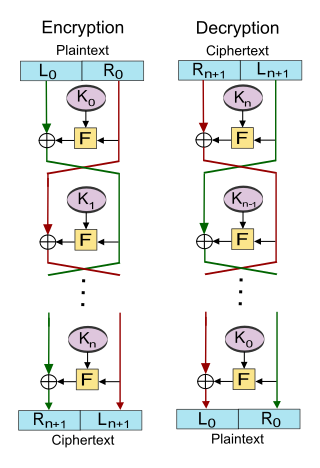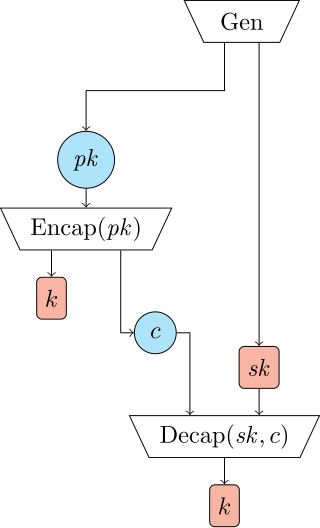In cryptography, a block cipher is a deterministic algorithm that operates on fixed-length groups of bits, called blocks. Block ciphers are the elementary building blocks of many cryptographic protocols. They are ubiquitous in the storage and exchange of data, where such data is secured and authenticated via encryption.

In cryptography, a cipher is an algorithm for performing encryption or decryption—a series of well-defined steps that can be followed as a procedure. An alternative, less common term is encipherment. To encipher or encode is to convert information into cipher or code. In common parlance, "cipher" is synonymous with "code", as they are both a set of steps that encrypt a message; however, the concepts are distinct in cryptography, especially classical cryptography.
RSA (Rivest–Shamir–Adleman) is a public-key cryptosystem, one of the oldest widely used for secure data transmission. The initialism "RSA" comes from the surnames of Ron Rivest, Adi Shamir and Leonard Adleman, who publicly described the algorithm in 1977. An equivalent system was developed secretly in 1973 at Government Communications Headquarters (GCHQ), the British signals intelligence agency, by the English mathematician Clifford Cocks. That system was declassified in 1997.
In cryptography, the ElGamal encryption system is an asymmetric key encryption algorithm for public-key cryptography which is based on the Diffie–Hellman key exchange. It was described by Taher Elgamal in 1985. ElGamal encryption is used in the free GNU Privacy Guard software, recent versions of PGP, and other cryptosystems. The Digital Signature Algorithm (DSA) is a variant of the ElGamal signature scheme, which should not be confused with ElGamal encryption.
Malleability is a property of some cryptographic algorithms. An encryption algorithm is "malleable" if it is possible to transform a ciphertext into another ciphertext which decrypts to a related plaintext. That is, given an encryption of a plaintext , it is possible to generate another ciphertext which decrypts to , for a known function , without necessarily knowing or learning .

In cryptography, a block cipher mode of operation is an algorithm that uses a block cipher to provide information security such as confidentiality or authenticity. A block cipher by itself is only suitable for the secure cryptographic transformation of one fixed-length group of bits called a block. A mode of operation describes how to repeatedly apply a cipher's single-block operation to securely transform amounts of data larger than a block.

In cryptography, ciphertext or cyphertext is the result of encryption performed on plaintext using an algorithm, called a cipher. Ciphertext is also known as encrypted or encoded information because it contains a form of the original plaintext that is unreadable by a human or computer without the proper cipher to decrypt it. This process prevents the loss of sensitive information via hacking. Decryption, the inverse of encryption, is the process of turning ciphertext into readable plaintext. Ciphertext is not to be confused with codetext because the latter is a result of a code, not a cipher.

In cryptography, a Feistel cipher is a symmetric structure used in the construction of block ciphers, named after the German-born physicist and cryptographer Horst Feistel, who did pioneering research while working for IBM; it is also commonly known as a Feistel network. A large number of block ciphers use the scheme, including the US Data Encryption Standard, the Soviet/Russian GOST and the more recent Blowfish and Twofish ciphers. In a Feistel cipher, encryption and decryption are very similar operations, and both consist of iteratively running a function called a "round function" a fixed number of times.
The Rabin cryptosystem is a family of public-key encryption schemes based on a trapdoor function whose security, like that of RSA, is related to the difficulty of integer factorization.
The Paillier cryptosystem, invented by and named after Pascal Paillier in 1999, is a probabilistic asymmetric algorithm for public key cryptography. The problem of computing n-th residue classes is believed to be computationally difficult. The decisional composite residuosity assumption is the intractability hypothesis upon which this cryptosystem is based.
In cryptography, a semantically secure cryptosystem is one where only negligible information about the plaintext can be feasibly extracted from the ciphertext. Specifically, any probabilistic, polynomial-time algorithm (PPTA) that is given the ciphertext of a certain message , and the message's length, cannot determine any partial information on the message with probability non-negligibly higher than all other PPTA's that only have access to the message length. This concept is the computational complexity analogue to Shannon's concept of perfect secrecy. Perfect secrecy means that the ciphertext reveals no information at all about the plaintext, whereas semantic security implies that any information revealed cannot be feasibly extracted.
Probabilistic encryption is the use of randomness in an encryption algorithm, so that when encrypting the same message several times it will, in general, yield different ciphertexts. The term "probabilistic encryption" is typically used in reference to public key encryption algorithms; however various symmetric key encryption algorithms achieve a similar property, and stream ciphers such as Freestyle which are inherently random. To be semantically secure, that is, to hide even partial information about the plaintext, an encryption algorithm must be probabilistic.
The Cramer–Shoup system is an asymmetric key encryption algorithm, and was the first efficient scheme proven to be secure against adaptive chosen ciphertext attack using standard cryptographic assumptions. Its security is based on the computational intractability of the Decisional Diffie–Hellman assumption. Developed by Ronald Cramer and Victor Shoup in 1998, it is an extension of the ElGamal cryptosystem. In contrast to ElGamal, which is extremely malleable, Cramer–Shoup adds other elements to ensure non-malleability even against a resourceful attacker. This non-malleability is achieved through the use of a universal one-way hash function and additional computations, resulting in a ciphertext which is twice as large as in ElGamal.
Ciphertext indistinguishability is a property of many encryption schemes. Intuitively, if a cryptosystem possesses the property of indistinguishability, then an adversary will be unable to distinguish pairs of ciphertexts based on the message they encrypt. The property of indistinguishability under chosen plaintext attack is considered a basic requirement for most provably secure public key cryptosystems, though some schemes also provide indistinguishability under chosen ciphertext attack and adaptive chosen ciphertext attack. Indistinguishability under chosen plaintext attack is equivalent to the property of semantic security, and many cryptographic proofs use these definitions interchangeably.
The Beaufort cipher, created by Sir Francis Beaufort, is a substitution cipher similar to the Vigenère cipher, with a slightly modified enciphering mechanism and tableau. Its most famous application was in a rotor-based cipher machine, the Hagelin M-209. The Beaufort cipher is based on the Beaufort square which is essentially the same as a Vigenère square but in reverse order starting with the letter "Z" in the first row, where the first row and the last column serve the same purpose.
Homomorphic encryption is a form of encryption that allows computations to be performed on encrypted data without first having to decrypt it. The resulting computations are left in an encrypted form which, when decrypted, result in an output that is identical to that of the operations performed on the unencrypted data. While homomorphic encryption does not protect against side-channel attacks that observe behavior, it can be used for privacy-preserving outsourced storage and computation. This allows data to be encrypted and outsourced to commercial cloud environments for processing, all while encrypted.
The Damgård–Jurik cryptosystem is a generalization of the Paillier cryptosystem. It uses computations modulo where is an RSA modulus and a (positive) natural number. Paillier's scheme is the special case with . The order of can be divided by . Moreover, can be written as the direct product of . is cyclic and of order , while is isomorphic to . For encryption, the message is transformed into the corresponding coset of the factor group and the security of the scheme relies on the difficulty of distinguishing random elements in different cosets of . It is semantically secure if it is hard to decide if two given elements are in the same coset. Like Paillier, the security of Damgård–Jurik can be proven under the decisional composite residuosity assumption.

In cryptography, a key encapsulation mechanism, or KEM, is a public-key cryptosystem that allows a sender to generate a short secret key and transmit it to a receiver securely, in spite of eavesdropping and intercepting adversaries. Modern standards for public-key encryption of arbitrary messages are usually based on KEMs.

Cryptography, or cryptology, is the practice and study of techniques for secure communication in the presence of adversarial behavior. More generally, cryptography is about constructing and analyzing protocols that prevent third parties or the public from reading private messages. Modern cryptography exists at the intersection of the disciplines of mathematics, computer science, information security, electrical engineering, digital signal processing, physics, and others. Core concepts related to information security are also central to cryptography. Practical applications of cryptography include electronic commerce, chip-based payment cards, digital currencies, computer passwords, and military communications.

















